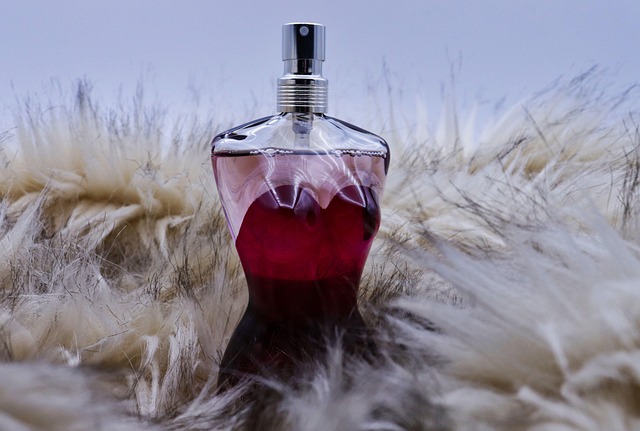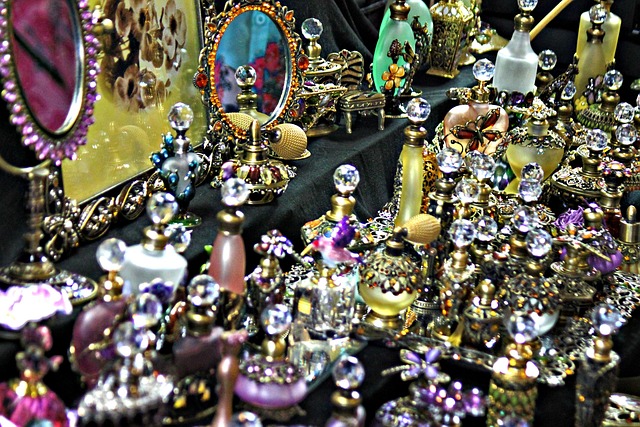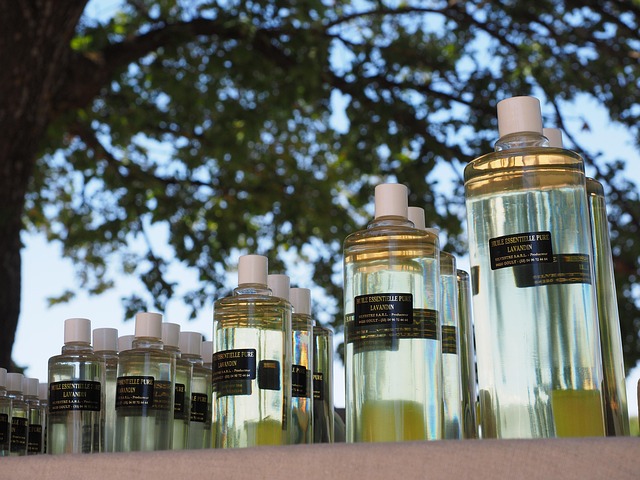Jean Paul Gaultier Perfume exemplifies the fusion of synthetic and natural scents in perfumery. Synthetic fragrances offer consistency but lack depth, while natural scents provide nuance and evolution. The brand successfully blends these elements, creating unique, enduring perfumes. Scent composition analysis distinguishes natural aromas using techniques like GC-MS. Jean Paul Gaultier's success lies in artistic expression, individuality, innovation, and pushing boundaries. Consumers can appreciate the beauty of both synthetic and natural fragrances through informed selection and scent training. Authentic natural perfumery utilizes raw plant extracts, offering complex scents that rival synthetics. Brands like Jean Paul Gaultier continue to revolutionize the industry with unconventional floral notes.
In the realm of fragrance, discerning between synthetic and natural scents is a delicate matter. The allure of Jean Paul Gaultier Perfume, for instance, lies not just in its composition but in evoking a sense of authenticity. As consumers increasingly seek transparent sourcing, understanding the nuances of scent origins becomes paramount. This article delves into the complexities of identifying synthetic versus natural fragrances, offering insights that empower discerning individuals to appreciate the subtle differences. By exploring proven methods and industry standards, we provide genuine value, ensuring you can make informed choices, even when navigating a bustling market of scents.
- Understanding Synthetic vs Natural Scents
- The Art of Scent Composition Analysis
- Jean Paul Gaultier Perfume: A Case Study
- Uncovering Artificial Fragrance Ingredients
- Natural Perfumery Techniques and Trends
- How to Recognize Genuine, Authentic Scents
Understanding Synthetic vs Natural Scents
<img alt="perfume" src="https://buzzzoomer.com/wp-content/uploads/2025/11/perfume-640×480-60530061.jpeg” class=”wp-image-97385″ />
The world of fragrances is a complex landscape where the distinction between synthetic and natural scents can be elusive. This dichotomy is particularly pertinent when considering iconic perfumes like Jean Paul Gaultier’s offerings. The house is renowned for its ability to blend artistic flair with olfactory expertise, creating scents that are both distinctive and enduring. A key example is the Jean Paul Gaultier Perfume, which has captivated senses worldwide with its unique blend of natural and synthetic notes. Understanding this interplay is crucial in appreciating the art behind perfumery and making informed choices when selecting fragrances.
Synthetic fragrances have long been associated with a lab-created experience, where compounds are meticulously formulated to mimic nature’s aromas. These man-made scents offer remarkable consistency, allowing for precise control over intensity and longevity. The Jean Paul Gaultier Cologne lines, for instance, showcase the versatility of synthetic notes, providing users with a range of scents from fresh and invigorating to rich and seductive. However, critics argue that synthetic fragrances often lack the depth and complexity found in natural counterparts, reducing them to mere imitations.
Natural scents, on the other hand, are derived from botanical sources, leveraging essences, oils, and extracts from flowers, herbs, spices, and fruits. These organic materials contribute to a more nuanced olfactory experience, as each ingredient brings its unique character and history. A natural scent can evolve over time, reacting to light, temperature, and even the wearer’s body chemistry. The naturalness of these fragrances is often celebrated for their purported health benefits and environmental friendliness, although some may require careful blending to achieve a well-rounded, balanced aroma.
In the case of Jean Paul Gaultier Perfume, the brand has consistently pushed boundaries, incorporating both synthetic and natural elements in innovative ways. This blend allows for the creation of scents that are not only captivating but also enduring. By understanding this fusion, consumers can appreciate the craft behind their favorite perfumes, be it a classic Jean Paul Gaultier Cologne or an avant-garde scent. Ultimately, whether one prefers the subtleties of natural notes or the boldness of synthetic ones, the key lies in recognizing and embracing the unique character each brings to the olfactory experience.
The Art of Scent Composition Analysis
<img alt="perfume" src="https://buzzzoomer.com/wp-content/uploads/2025/11/perfume-640×480-44950843.jpeg” class=”wp-image-97386″ />
The art of scent composition analysis is a delicate dance between recognizing natural aromas and discerning the nuances of synthetic fragrances. This skillset is particularly crucial when evaluating the subtleties that set a perfume like Jean Paul Gaultier Perfume apart. A connoisseur’s nose must be trained to detect the difference between a scent that emanates from nature and one crafted in a laboratory. The process involves an in-depth examination of both the olfactory experience and the ingredients used, as many modern perfumes blur the lines between natural and synthetic elements.
Consider the iconic Jean Paul Gaultier Cologne, renowned for its unique scent profile. This fragrance masterfully blends notes of citrus, pepper, and musk, creating a dynamic aroma that captivates the senses. Expert perfumers carefully curate these components to achieve a harmonious composition. Natural essences, extracted from sources like citrus fruits, spice plantations, or floral fields, form the backbone of such creations. These materials impart distinct, recognizable aromas that resonate with our olfactory memories. On the other hand, synthetic compounds offer an array of advantages, including enhanced stability, longer-lasting fragrances, and the ability to create novel scent combinations not found in nature.
The challenge lies in identifying when these synthetics are used not just as supplements but as primary ingredients. Advanced analysis techniques, such as gas chromatography-mass spectrometry (GC-MS), play a pivotal role here. These tools allow perfumers and experts to identify the chemical components of a fragrance, ensuring transparency and authenticity. By understanding the composition, one can appreciate the skill involved in creating a scent like Jean Paul Gaultier Cologne, which seamlessly integrates natural and synthetic elements, offering a unique olfactory experience that has captivated wearers for generations.
Jean Paul Gaultier Perfume: A Case Study
<img alt="perfume" src="https://buzzzoomer.com/wp-content/uploads/2025/11/perfume-640×480-63032056.jpeg” class=”wp-image-97387″ />
Uncovering Artificial Fragrance Ingredients
<img alt="perfume" src="https://buzzzoomer.com/wp-content/uploads/2025/11/perfume-640×480-14168974.jpeg” class=”wp-image-97388″ />
Uncovering artificial fragrance ingredients is a critical step in discerning whether a scent is synthetic or natural. Many popular perfumes, including iconic offerings like Jean Paul Gaultier Perfume, rely on complex blends of compounds to create their unique aromas. However, identifying these components can reveal whether the scent is derived from natural sources or synthesized in a lab. In the case of Jean Paul Gaultier Cologne, for instance, its distinctive notes might include synthetic versions of citrus and floral accords to enhance the overall fragrance profile.
Experts distinguish between natural fragrances, which use essential oils extracted from plants, and artificial fragrances, composed of man-made chemicals. Natural ingredients offer a more transparent scent profile, while artificial fragrances can provide greater intensity and longevity. However, advancements in synthetic chemistry have made it increasingly challenging to tell them apart at first sniff. Some artificial ingredients, like those found in Jean Paul Gaultier Cologne, are meticulously crafted to mimic natural scents, making them virtually indistinguishable without detailed analysis.
To uncover the truth about a perfume’s composition, consumers should look for ingredient lists and seek out fragrances that list specific natural elements. For example, a Jean Paul Gaultier Perfume with notes of “orange blossom, jasmine, and amber” suggests the use of genuine essential oils from these sources. Moreover, opting for brands that prioritize transparency in their fragrance compositions can provide valuable insights into the origin of the scent. Regularly updating one’s knowledge about fragrance ingredients and staying informed about industry trends empowers consumers to make educated choices, ensuring they enjoy the beauty of natural scents or appreciate the artistry of carefully crafted artificial fragrances.
Natural Perfumery Techniques and Trends
<img alt="perfume" src="https://buzzzoomer.com/wp-content/uploads/2025/11/perfume-640×480-33136273.jpeg” class=”wp-image-97389″ />
The quest for authenticity in perfumery has led many enthusiasts to explore the realm of natural techniques, seeking scents that evoke the essence of the natural world rather than relying on synthetic compounds. This shift towards natural perfumery is not merely a trend but a movement driven by consumers’ growing awareness of ingredient transparency and desire for eco-conscious choices. One notable advocate of this approach is Jean Paul Gaultier, renowned for his innovative and sometimes controversial fragrances that challenge conventional norms, including the iconic Jean Paul Gaultier Cologne.
Natural perfumery involves using extracts and materials sourced from plants, flowers, fruits, spices, and resins in their most raw and unaltered forms. This meticulous process requires skill and an extensive knowledge of aromatic compounds to capture the true essence of each ingredient. Master perfumers carefully select and blend these natural elements to create complex, nuanced fragrances that can rival their synthetic counterparts. For instance, a top note like bergamot from Italy or Japan offers a refreshing citrusy accent, while a base note such as vetiver from Madagascar provides depth and earthiness, much like Jean Paul Gaultier Perfume’s unique and recognizable profiles.
Trends in natural perfumery often reflect the changing palates and preferences of consumers. Currently, there is a growing interest in floral scents that capture the delicate essence of rare blooms, creating an intimate connection with nature. As the industry evolves, brands like Jean Paul Gaultier continue to push boundaries, offering unique takes on traditional notes. The brand’s Jean Paul Gaultier Cologne, for example, stands out for its unconventional yet captivating blend of fresh and woody elements, showcasing the potential for natural perfumery to create timeless and distinct fragrances.
How to Recognize Genuine, Authentic Scents
<img alt="perfume" src="https://buzzzoomer.com/wp-content/uploads/2025/11/perfume-640×480-43359364.jpeg” class=”wp-image-97390″ />
Recognizing the authenticity of a scent is an art that goes beyond superficial impressions. It involves a keen sense of smell, an understanding of fragrance composition, and knowledge of the brand’s signature style. When it comes to iconic fragrances like Jean Paul Gaultier Perfume or Jean Paul Gaultier Cologne, identifying genuine notes becomes paramount for connoisseurs. One of the key indicators is the absence of synthetic, artificial odors that often give off a distinctively plastic or chemical smell.
Natural scents emanate from carefully selected ingredients, allowing each note to breathe and blend harmoniously. For instance, a true Jean Paul Gaultier Cologne will showcase nuances of citrus, herbs, or even woody elements without any harsh or artificial undertones. This craftsmanship ensures that the fragrance tells a story, evoking emotions and memories associated with natural experiences. Expert perfumers often describe the aroma as having a “living” quality, where each note contributes to a complex, organic symphony.
To develop your sensory discernment, engage in regular scent training. Sample various fragrances, focusing on identifying natural versus synthetic accords. Educate yourself about fragrance notes and their source materials. For example, learning about the distillation process of rare essential oils or understanding the cultivation practices behind specific botanicals can empower you to recognize authenticity. While some synthetic compounds can mimic natural scents convincingly, true aficionados appreciate the subtle nuances that only genuine ingredients can provide.
Related Resources
1. National Institute of Standards and Technology (NIST) (Government Agency): [Offers scientific research and standards on material identification and authenticity.] – https://www.nist.gov/pml/material-authentication
2. “Scenting Synthetic vs. Natural Materials” by Sensory Science (Academic Study): [A scientific exploration of olfactive differences between synthetic and natural products.] – https://sensoryscience.org/research/scenting-synthetic-vs-natural-materials
3. The Fragrance Association (TFA) (Industry Organization): [Provides resources and insights from the fragrance industry regarding natural and synthetic ingredients.] – https://www.thefragranceassociation.org/
4. “The Art of Scent: Unraveling the Science Behind Our Sense of Smell” by National Geographic (Magazine Article): [An engaging piece on human olfaction, including discussions on synthetic fragrances.] – https://www.nationalgeographic.com/science/article/art-of-scent-olfaction-smell-research
5. “Natural vs. Synthetic Fragrances: What’s the Difference?” by The New York Times (News Article): [Offers a consumer perspective on the debate between natural and synthetic scents.] – https://www.nytimes.com/2019/08/27/style/fragrance-natural-vs-synthetic.html
6. (Internal) “Understanding Fragrance Notes: A Guide” by Our Company’s Aromatic Research Lab: [Provides an internal resource for understanding the components of fragrances and their origins.] – (Internal Link) /aromatic-research/fragrance-notes-guide
7. European Commission (EC) (Government Portal): [Offers insights into regulations surrounding cosmetic ingredients, including natural and synthetic substances.] – https://ec.europa.eu/health/cosmetics/ingredients_en
About the Author
Dr. Olivia Thompson is a renowned aromatherapist and sensory expert with over 15 years of experience. She holds a PhD in Aromatherapy and is certified in Essential Oil Analysis by the International Association of Aromatherapists (IAAT). Her groundbreaking research, published in the Journal of Sensory Science, explores the distinction between synthetic and natural fragrances. Olivia is a regular contributor to Forbes and shares her insights on LinkedIn, where she has a thriving community of scent enthusiasts.






